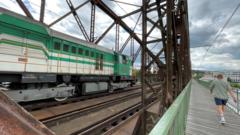Is the Prague Railway Project Going Too Far?

Preserving Prague's Architectural Heritage: The Vysehrad Railway Bridge Debate
Prague, the enchanting capital of the Czech Republic, is renowned for its architectural splendor, drawing millions of tourists each year. Nestled along the Vltava River, the city boasts a rich tapestry of styles, from the Gothic spires of St. Vitus Cathedral to the intricate facades of Baroque palaces. However, the preservation of its historical landmarks is a subject of heated debate, particularly in the case of the Vysehrad Railway Bridge. This article delves into the controversy surrounding this iconic structure, the implications of its potential demolition, and the broader significance of architectural preservation in a city that cherishes its historical identity.
The Vysehrad Railway Bridge: A Historical Overview
Constructed in 1902 during the height of the Austro-Hungarian Empire, the Vysehrad Railway Bridge stands as a testament to the engineering prowess of its time. Spanning the Vltava River, the bridge is characterized by its three distinct arches and robust steel girders, which have become an iconic part of Prague's skyline. As one of the key transport arteries in the city, it currently supports a significant portion of Prague’s railway traffic, facilitating connectivity to various regions, including Karlovy Vary and Pilsen.
The Architectural Significance
The Vysehrad Railway Bridge is not just a functional structure; it is an integral part of Prague's architectural narrative. The panoramic view it creates in conjunction with the Vysehrad Fortress is comparable to that of the Charles Bridge and Prague Castle. Architect and bridge engineer Petr Tej emphasizes the importance of this visual relationship, stating that the bridge is "absolutely key to Prague." Its historical and aesthetic value cannot be overstated; it embodies a unique blend of industrial design and architectural elegance.
Present Condition and Challenges
Despite its historical significance, the bridge is facing serious structural challenges. Years of exposure to the elements have resulted in significant corrosion, particularly in the riveted joints and beams. Experts estimate that while previous reports suggested a need to replace 70% of the steel, newer assessments indicate that only 15% requires replacement. This discrepancy raises questions about the necessity of the Railway Authority's plans to dismantle the bridge entirely.
The Debate: Preservation vs. Modernization
The proposed demolition of the Vysehrad Railway Bridge has ignited a passionate debate among architects, engineers, conservationists, and the general public. On one side, the Railway Authority argues that the bridge's current condition compromises its ability to support increasing railway traffic. Pavel Paidar, Director of the Railway Authority’s Construction Preparation Department, points out that the bridge currently operates at only 60% of its capacity due to corrosion. He advocates for a new bridge that would not only accommodate more trains but also enhance the overall transport infrastructure in Prague.
The Case for Preservation
Conversely, advocates for preservation, including the Vysehrad Bridge Foundation, argue that the bridge can be repaired without compromising its historical integrity. They propose a plan to repair the existing structure while maintaining its operational capacity, which would minimize disruption and be cost-effective. The Foundation’s findings have garnered support from UNESCO and over 25,000 local residents who signed a petition advocating for the bridge's restoration.
Compromise Solutions
In light of the ongoing debate, some experts propose a compromise solution that allows for both the preservation of the historical bridge and the expansion of the railway capacity. This could involve constructing a new, slender bridge alongside the existing one to accommodate additional tracks without sacrificing the visual and historical significance of the original structure. This approach seeks to harmonize the need for modern transport solutions with the imperative of protecting cultural heritage.
Broader Implications for Architectural Preservation
The debate surrounding the Vysehrad Railway Bridge reflects a broader dilemma faced by cities around the world: the challenge of balancing modernization with the preservation of cultural heritage. In a city like Prague, which prides itself on its architectural conservation, this dilemma is particularly pronounced. The city's historical landmarks are not merely relics of the past; they are integral to the identity and character of Prague.
The Role of Public Engagement
Public opinion plays a crucial role in shaping the outcome of such debates. The overwhelming support for preserving the Vysehrad Railway Bridge underscores the importance of community engagement in decision-making processes related to historical landmarks. The voices of residents, historians, and architects should be considered as part of a holistic approach to urban planning that respects both heritage and progress.
Lessons from Other Cities
Prague is not alone in grappling with the tension between modernization and preservation. Cities like Paris, Rome, and Istanbul have faced similar challenges. In many cases, successful outcomes have been achieved through collaborative efforts that prioritize community input, innovative design solutions, and a commitment to preserving cultural heritage. These examples serve as valuable lessons for Prague as it navigates its own architectural dilemmas.
Conclusion: A Call for Thoughtful Decision-Making
As the debate over the Vysehrad Railway Bridge unfolds, it is essential for stakeholders—including government officials, transport authorities, and the public—to engage in thoughtful decision-making that considers both the practical needs of modern transport and the cultural significance of historical landmarks. The outcome of this debate will have lasting implications for Prague's architectural landscape and its identity as a city that cherishes its rich heritage.
Ultimately, the decision to preserve or replace the Vysehrad Railway Bridge will likely not be made by engineers or heritage advocates alone, but by the Czech government, which holds the responsibility to balance these conflicting interests. The future of this iconic bridge hangs in the balance, symbolizing a pivotal moment in Prague's ongoing narrative of preservation and progress.
FAQs about the Vysehrad Railway Bridge Debate
What is the historical significance of the Vysehrad Railway Bridge?
The Vysehrad Railway Bridge, built in 1902, is a key part of Prague's architectural history. It exemplifies the engineering achievements of the Austro-Hungarian era and creates an iconic skyline alongside the Vysehrad Fortress.
Why is there a debate over the bridge's demolition?
The debate centers on the bridge's structural integrity and its ability to handle increasing railway traffic. While the Railway Authority advocates for a new bridge, preservation advocates argue that the existing structure can be repaired without compromising its historical value.
What are the proposed alternatives to demolition?
One proposal involves repairing the existing bridge while constructing a new, slender bridge alongside it to accommodate additional railway tracks. This approach seeks to balance modernization with the preservation of cultural heritage.
As the future of the Vysehrad Railway Bridge is deliberated, what are your thoughts on the balance between modern infrastructure demands and the preservation of historical sites? #PragueHeritage #VysehradBridge #ArchitectureDebate
Published: 2025-07-12 01:21:27 | Category: technology



